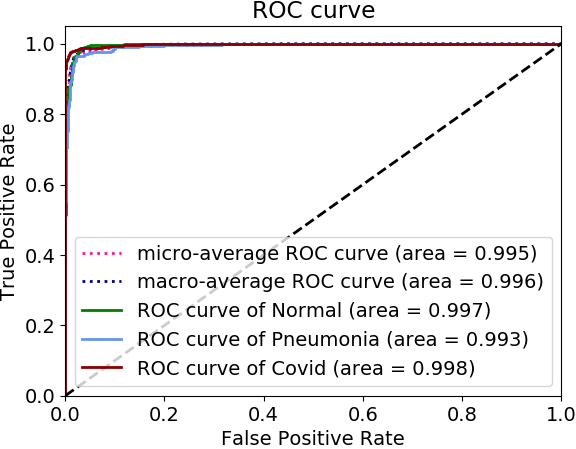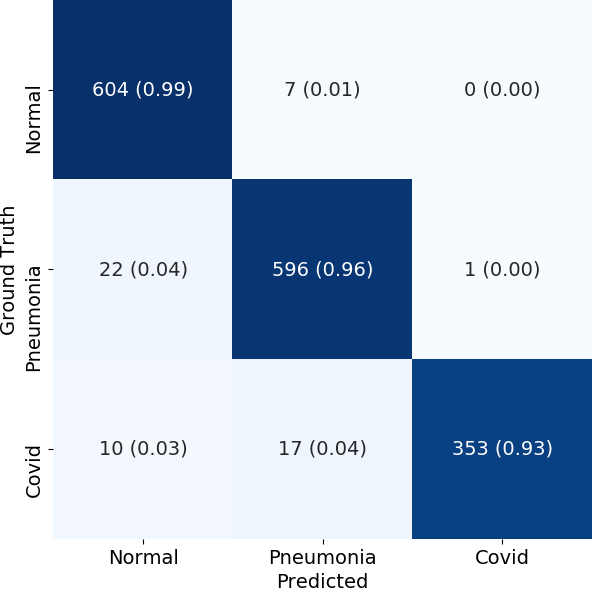Disclaimer: All algorithms have false positive and false negative results. The AI tool should not be used as a standalone test. The final right of diagnosis in a clinical setting should always lie with the physician.
Link of the Paper: Click Here
Chest Radiography (CXR) is among the most common investigations performed world-over and accounts for 25% of total diagnostic imaging procedures. It is a portable, inexpensive, and a safe modality, which is widely used to assess the extent of lung involvement in a wide variety of thoracic pathologies. It is widely available in hospital set-ups even in small peripheral centres and involves minimal contact with the patient. However, CXR has not been seen to be sensitive or specific for changes of COVID-19. While many patients do not show any changes on chest radiography (to an expert eye), those who do show changes are difficult to differentiate from other forms of pneumonia.
We introduce CovidAID which takes a CXR as an input and outputs either 3-Class probabilities: Normal, Pneumonia and Covid-19 or 4-Class probabilities: Normal, Bacterial Pneumonia, Viral Pneumnonia and Covid-19. It consists of 3 models: Global Model: which incorporates the whole input image to make a decision, Local Model: which incorporates the discriminative features extracted from global model to make a decision and Fusion Model: which uses both global and local features obtained from above models to make a decision.
It is based on Diagnose like a Radiologist: Attention Guided Convolutional Neural Network for Thorax Disease Classification and its reimplementation by Ien001. The initial weights used for training were obtained from CheXNet.
CovidAID uses the covid-chestxray-dataset, BSTI-dataset, BIMCV, IIT-KGP for COVID-19 X-Ray images and chest-xray-pneumonia, RSNA dataset for data on Pneumonia and Normal lung X-Ray images.
More datasets can be added as required by making changes in data_tools/prepare_covid_data.py and data_tools/prepare_data.py. It is recommended to use the 3 class classification, rather than 4-class, as information on viral/bacterial etiology is available only in the chest-xray-pneumonia dataset, which only has pediatric patients. The 4 class classification therefore has not been studied in the adult patient population. The above mentioned datasets should be downloaded and placed in the root of this directory.
Clone this repo:
git clone https://github.com/sumanyumuku98/CovidAid_V2.git
Create venv:
conda env create -f env.yml
conda activate covidaid
Remove the --combine_pneumonia flag in below cases for 4-class classification.
- Prepare Covid-19 Dataset:
python data_tools/prepare_covid_data.py --bsti --kgp_action --bmcv
- Make sure that the name of folders is similar to that mentioned in
prepare_covid_data.pyfor the above mentioned datasets.
- Combine all Data:
python data_tools/prepare_data.py --combine_pneumonia --bsti --kgp_action --bmcv
- Labels Assigned to respective categories:
- Class 0: Normal
- Class 1: Pneumonia
- Class 2: Covid-19
This script is used to transfer the CheXNet weights from here to our model and replace the final layer with 3 or 4 classes respectively. By default, the transferred weights have been provided in data/ folder and you won't need to run this. But in case you want to initialize the model with different number of classes then you can run this.
python tools/transfer.py --combine_pneumonia
By default the weights are saved in models/ folder but it is advised to specify some other directory for saving the weights.
python tools/train_AGCNN.py --mode train --ckpt_init data/CovidXNet_transfered_3.pth.tar --combine_pneumonia --epochs 100 --bs 16 --save <path_to_save_dir>
In order to resume training:
python tools/train_AGCNN.py --mode train --resume --ckpt_G <Path_To_Global_Model> --ckpt_L <Path_To_Local_Model> --ckpt_F <Path_To_Fusion_Model> --save <Path_To_Save_Dir> --combine_pneumonia
Binary evaulation can be done i.e Non-Covid V/s Covid by setting binary_eval=True in test function in tools/train_AGCNN.py. By default, it will compute metrics for classes based on --combine_pneumonia flag.
python tools/train_AGCNN.py --mode test --combine_pneumonia --ckpt_G <Path_To_Best_Global_Model> --ckpt_L <Path_To_Best_Local_Model> --ckpt_F <Path_To_Best_Fusion_Model> --bs 16 --cm_path plots/cm_best --roc_path plots/roc_best
In order to get RISE visualizations and class probabilities on a set of images:
python tools/inference.py --combine_pneumonia --checkpoint <Path_To_Best_Global_Model> --img_dir <Path_To_Images> --visualize_dir <Path_To_Out_Dir>
In order to get Attention maps and class probabilities:
python tools/train_AGCNN.py --mode visualize --combine_pneumonia --img_dir testsample --visualize_dir testresults --ckpt_G models/Gloval_Best.pth --ckpt_L models/Local_Best.pth --ckpt_F models/Fusion_Best.pth
By default, the best weights have been provided in models/ directory and will be used when no checkpoint paths have been provided in the inference scripts.
We obtained an accuracy of around 96.46% on the public test set. The mean AUROC for 3-Class configuration was around 0.996. The respective confusion matrix and ROC curve has been shown below:
| 3-Class Classification | |||||||||||||||||
|---|---|---|---|---|---|---|---|---|---|---|---|---|---|---|---|---|---|
| |||||||||||||||||
| ROC curve | |||||||||||||||||
| Confusion Matrix |
@article{Rangarajan_2021,
doi = {10.1007/s00330-020-07628-5},
url = {https://doi.org/10.1007%2Fs00330-020-07628-5},
year = 2021,
month = {jan},
publisher = {Springer Science and Business Media {LLC}},
author = {Krithika Rangarajan and Sumanyu Muku and Amit Kumar Garg and Pavan Gabra and Sujay Halkur Shankar and Neeraj Nischal and Kapil Dev Soni and Ashu Seith Bhalla and Anant Mohan and Pawan Tiwari and Sushma Bhatnagar and Raghav Bansal and Atin Kumar and Shivanand Gamanagati and Richa Aggarwal and Upendra Baitha and Ashutosh Biswas and Arvind Kumar and Pankaj Jorwal and Shalimar and A. Shariff and Naveet Wig and Rajeshwari Subramanium and Anjan Trikha and Rajesh Malhotra and Randeep Guleria and Vinay Namboodiri and Subhashis Banerjee and Chetan Arora},
title = {Artificial Intelligence{\textendash}assisted chest X-ray assessment scheme for {COVID}-19},
journal = {European Radiology}
}
.png)

